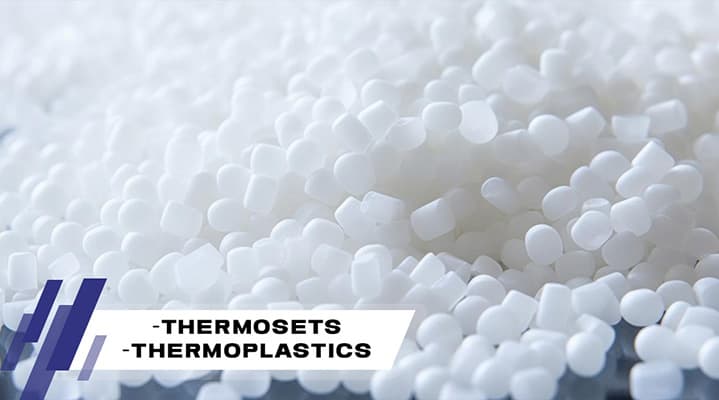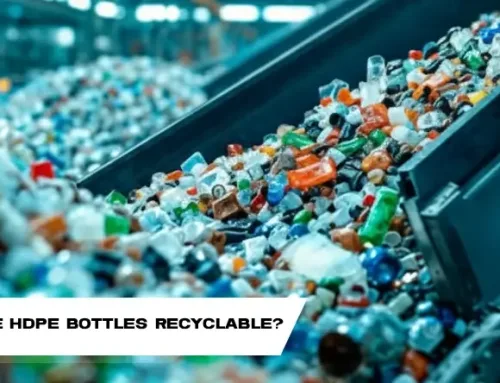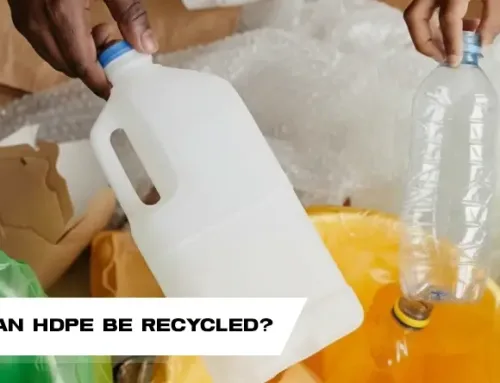Thermosets and thermoplastics are two distinct classes of polymeric materials that exhibit unique properties and behaviors. Due to their diverse characteristics and performance capabilities, these materials find applications across various industries, including automotive, construction, electronics, and aerospace. Understanding the fundamental differences between thermosets and thermoplastics is crucial for selecting the appropriate material for a specific application.
Key Differences Between Thermosets and Thermoplastics
| Thermosets | Thermoplastics |
|---|---|
| Thermosets undergo an irreversible chemical cross-linking reaction during curing, forming a rigid, three-dimensional network structure. | Thermoplastics have linear or slightly branched polymer chains held together by weaker intermolecular forces without cross-linking. |
| Thermosets cannot be remelted or reshaped once cured, as the cross-links are permanent. | Thermoplastics can be repeatedly melted and reshaped by heating and cooling without any chemical change. |
| Thermosets have excellent thermal stability and can withstand high temperatures without melting or deforming due to their tightly cross-linked structure. | Thermoplastics soften and melt when heated above their melting or glass transition temperature. |
| Chemical resistance: Thermosets generally have better chemical resistance than thermoplastics due to their highly cross-linked structure. | – |
| Strength and rigidity: Thermosets tend to be more rigid, stronger, and have better dimensional stability than thermoplastics, especially at elevated temperatures. | – |
| Recyclability: Thermoplastics can be recycled and reused by remelting, while thermosets cannot be recycled or remolded once cured. | – |
What Are Thermosets?
Thermosets are polymers that undergo a chemical process called cross-linking during their curing or hardening phase. This cross-linking reaction creates a three-dimensional network of covalent bonds, rendering the material highly rigid and resistant to heat, solvents, and chemicals.
| Definition | A polymer that hardens irreversibly into an infusible and insoluble network through curing, often initiated by heat or radiation. |
|---|---|
| Curing Process | The process involves chemical reactions induced by heat, radiation, high pressure, or a catalyst, resulting in extensive cross-linking between polymer chains. |
| Pre-curing Form | Starts as a malleable or liquid prepolymer designed to be molded into final shapes or used as an adhesive. |
| Comparison with Thermoplastics | Once hardened, thermosetting polymers cannot be melted and reshaped, unlike thermoplastics. |
| Applications | Used for making molded products and as adhesives due to their ability to take and hold complex shapes. |
Characteristics of Thermosets
- Irreversible Curing
Once cured, thermosets cannot be remelted or reshaped, as the cross-linking process is irreversible.
- High Thermal Stability
Thermosets exhibit excellent thermal stability and can withstand high temperatures without deforming or losing their structural integrity.
- Chemical Resistance
The cross-linked structure of thermosets makes them resistant to many chemicals, solvents, and environmental factors.
- Dimensional Stability
Thermosets maintain their shape and size even under extreme conditions, making them suitable for applications requiring precise dimensions.
- Electrical Insulation
Many thermoset materials possess excellent electrical insulation properties, making them suitable for use in electrical and electronic
- Excellent Mechanical Properties
Thermosets generally possess high rigidity and strength, making them suitable for structural applications. Their mechanical robustness is often superior to that of thermoplastics.
Common Thermosets
- Epoxy resins
- Polyurethanes
- Phenolic resins
- Unsaturated polyesters
- Melamine-formaldehyde resins
What Are Thermoplastics?
Thermoplastics, on the other hand, are polymers that can be repeatedly melted and reshaped without undergoing a chemical change. These materials consist of linear or slightly branched polymer chains held together by relatively weak intermolecular forces.
When heated above their melting or glass transition temperature, thermoplastics become soft and moldable, allowing them to be reshaped or reformed. Upon cooling, they solidify into a rigid state without undergoing any chemical cross-linking or permanent changes in their molecular structure. This heating and cooling cycle can be repeated multiple times, making thermoplastics recyclable and reusable.
| Definition | A plastic polymer material that can be repeatedly softened when heated and hardened when cooled. |
|---|---|
| Curing Process | Becomes pliable or moldable at a certain elevated temperature and solidifies upon cooling. |
| Pre-curing Form | Most thermoplastics have a high molecular weight with polymer chains associating by intermolecular forces. |
| Comparison with Thermoplastics | Used to produce parts by injection molding, compression molding, calendering, and extrusion. |
| Applications | Physical properties change drastically between glass transition temperature and melting point without an associated phase change. |
| Optical Clarity | Amorphous and semi-amorphous plastics used for high optical clarity due to less light scattering by crystallites. |
| Improving Flexibility | Brittleness decreased with addition of plasticizers or by modification of the polymer through copolymerization. |
Characteristics of Thermoplastics
- Reversible Melting and Solidification
Thermoplastics can be melted and reshaped by applying heat and pressure, and they solidify upon cooling, allowing for easy processing and recycling.
- Ductility and Toughness
Thermoplastics exhibit ductility and toughness, making them resistant to impact and capable of undergoing plastic deformation without fracturing.
- Thermal Insulation
Many thermoplastics have excellent thermal insulation properties, making them suitable for applications requiring insulation from heat or cold.
- Ease of Processing
Thermoplastics can be easily processed using techniques such as injection molding, extrusion, and blow molding, allowing for the production of complex shapes and intricate designs.
- Recyclability
Thermoplastics can be recycled and reprocessed multiple times, making them environmentally friendly and cost-effective.
- Mechanical Properties
Thermoplastics offer great toughness and impact resistance and can be tailored to be flexible or rigid, providing versatility in product design.
Common Thermoplastic Polymers
- Polyethylene (PE) – Used for packaging, bottles, pipes, and films.
- Polypropylene (PP) – Used for automotive parts, containers, fibers, and carpets.
- Polyvinyl chloride (PVC) – Used for pipes, window frames, flooring, and wire insulation.
- Polystyrene (PS) – Used for food packaging, disposable utensils, and insulation.
- Polyethylene terephthalate (PET) – Used for beverage bottles, food containers, and fibers.
- Polycarbonate (PC) – Used for electronic components, construction materials, and automotive parts
Applications of Thermosets and Thermoplastics
Advantages and Disadvantages Thermosets
| Advantages | Disadvantages |
|---|---|
| Excellent thermal stability and heat resistance due to cross-linked structure. | Cannot be remelted or reshaped once cured due to permanent cross-linking. |
| High strength-to-weight ratio and dimensional stability. | Non-recyclable and difficult to dispose of. |
| Superior chemical resistance and corrosion resistance. | Tend to be more rigid and brittle, with lower impact resistance. |
| Good electrical insulation properties. | Challenging to surface finish and machine due to hardness. |
| Low manufacturing costs due to simpler molding processes. | Poor thermal conductivity. |
Advantages and Disadvantages Thermoplastics
| Advantages | Disadvantages |
|---|---|
| Can be remelted and reshaped repeatedly without significant degradation. | Lower thermal stability and heat resistance compared to thermosets. |
| Recyclable and reusable, promoting sustainability. | Can soften, deform, or melt at elevated temperatures. |
| Good impact resistance and toughness. | Susceptible to creep and stress relaxation over time. |
| Excellent chemical resistance for many applications. | Generally more expensive than thermosets for similar applications. |
| Easy to process, mold, and surface finish. | May degrade when exposed to UV radiation or certain chemicals. |
| Lightweight yet durable. | – |
The choice between thermosets and thermoplastics depends on the specific application requirements, such as thermal stability, chemical resistance, impact resistance, cost, and recyclability needs.






This website contains a lot of fascinating and informative information.
On this platform, you can learn about a wide range of subjects that broaden your horizons.
Visitors will value the resources shared on this site.
Every category is organized clearly, making it pleasant to use.
The articles are easy to understand.
It’s possible to find recommendations on various fields.
Whether your interest is in educational content, this site has what you’re looking for.
To sum up, this platform is a great source for those who love learning.